
Safety, ease of use, and multi-tasking performance are big concerns when fire departments seek new apparatus, no matter what type.
Many departments, whether faced with budgetary issues or staffing issues, are asking manufacturers to build vehicles that can be used for more than one and sometimes several disciplines.
Mark Brenneman, assistant sales manager for 4 Guys Fire Trucks, points out 4 Guys recently built a triple-threat rig for the Ashville (PA) Fire Department—a pumper-tanker-rescue. “With the universal staffing shortage in the fire service, fire departments are trying to do as much as they can to get as many functions on one apparatus as possible,” Brenneman observes. “The challenge for us and other manufacturers is to figure out how to fit everything the department wants on the vehicle that may have to go into a 50-year-old station with not much space around it.”
- Multi-Use, Fast-Acting Fire Apparatus in Rural Communities
- Pattonville (MO) Fire Department Gets Multi-Use Pumper That Functions in Rescue and Industrial Roles
- San Bernardino County (CA) Fire Puts New Tender in Service
- Alexis Fire Equipment Pumper-Tanker-Rescue
- McAdoo (PA) Fire Company Gets Pumper-Tanker-Rescue from KME
- Is the Traditional Tanker Dead, or Is It on Life Support?

1 4 Guys Fire Trucks built this pumper-tanker-rescue on a Spartan Gladiator chassis and cab for the Ashville (PA) Fire Department. (Photo 1 courtesy of 4 Guys Fire Trucks.)
Brenneman says the pumper-tanker-rescue that 4 Guys built for Ashville is on a Spartan Gladiator tandem rear axle chassis and long four-door cab with a 2,000-gallon per minute (gpm) pump, an 1,800-gallon water tank, a 15-kilowatt (kW) generator, a light tower, and a five-bottle air cascade system with a fill station.
Joe Messmer, president of Summit Fire Apparatus, agrees that multi-use apparatus are what fire departments are asking for most these days because they are looking for the most efficient use of their staffs and vehicles.

2 Summit Fire Apparatus built this rescue-pumper with a 1,500-gpm midship-mounted pump and 16-foot aluminum rescue body for the Crescent Villa (KY) Fire Authority. (Photo 2 courtesy of Summit Fire Apparatus.)
“Rescue-pumpers are still the most popular apparatus,” Messmer notes, “and even smaller versions like a light rescue-pumper that we’re building on a Ford F-550 chassis with a midship pump and rescue body are seeing more use.”
Pumper-tankers have been popular for a number of years now, Messmer maintains. “We’ve built several pumper-tankers with a portable pump in a compartment on a slide-out tray and also versions with a Hale Sidekick pump that doesn’t take up much space as well as full-blown pumper-tankers with a side-mount pump, crosslays, and a full hosebed in addition to a large water tank,” he says.
Alex Hobday, sales engineer for Spencer Manufacturing Inc., says Spencer recently built a pumper-tanker-rescue on a Spartan Metro Star chassis and long four-door cab with a 10-inch raised roof and seating for six firefighters for the Raisin Township (MI) Fire Department. “The vehicle has a Hale Qmax 2,000-gpm pump, a 2,500-gallon water tank, side and rear dumps, split-depth compartments, a Command Light LED light tower, a remote-controlled deck gun, and EMS (emergency medical services) cabinets in the crew cab,” Hobday points out.
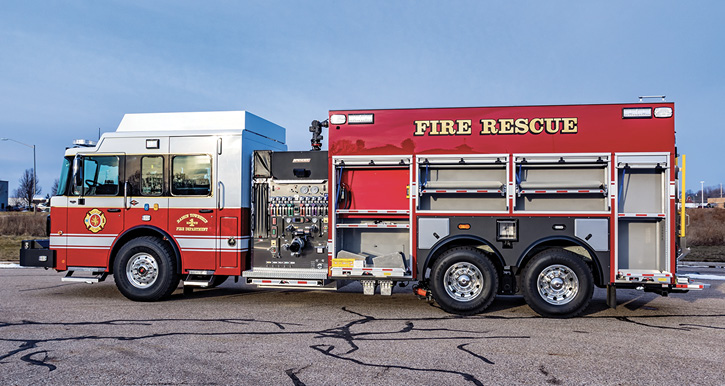
3 Spencer Manufacturing built this pumper-tanker-rescue with a Hale Qmax 2,000-gpm pump and 2,500-gallon water tank for the Raisin Township (MI) Fire Department. (Photo 3 courtesy of Spencer Manufacturing Inc.)
Chris Wade, director of sales for Spartan Emergency Response, says that quints and quads are likely the first multi-functional apparatus used in the fire service. Simply stated, a quint is a fire apparatus that combines the equipment capabilities of a ladder truck and the water pumping ability of a fire engine by carrying five main tools to carry out firefighting functions: an aerial device, a fire pump, a water tank, ground ladders, and a hosebed load. A quad omits the fire hose supply line complement. Wade notes that Spartan ER has built quints and quads for years and that they are serving in departments around the country.
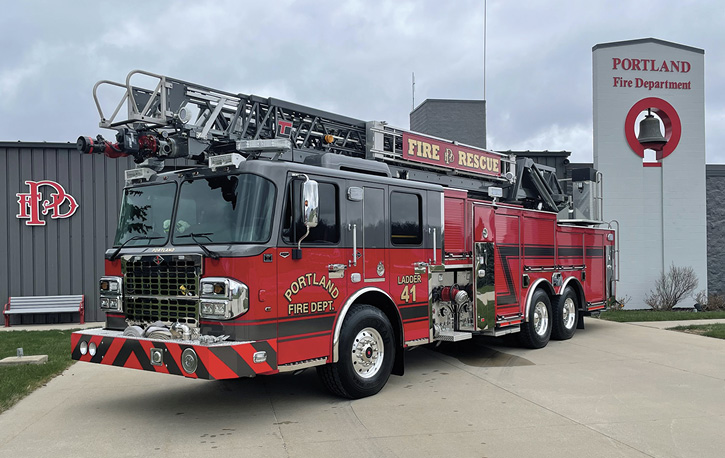
4 This NXT 110-foot aerial ladder quint was built by Spartan Emergency Response for the Portland (IN) Fire Department. (Photo 4 courtesy of Spartan Emergency Response.)
In another multi-use example, Wade says Spartan ER built a rescue-pumper for the Milan Area (MI) Fire Department; the agency runs chiefly as an EMS squad. “It has rescue tools; an air fill station; extra air bottles; a winch on the rear; a light tower; a stokes basket and backboards; and also a pump, a water tank, and speedlays,” Wade says.
Tim Smits, senior sales manager for aerial products at Pierce Manufacturing Inc., says more fire departments are buying more quints than aerials with no pump and no tank, what many people refer to as a “true truck.” Smits adds that Pierce developed the Ascendant 107-foot single-rear axle aerial ladder, which often is outfitted as a quint, to be more compact and maneuverable as well as to be able to run at the speed of a pumper. “Our mid-mount Ascendant aerial platform also can be set up as a quint or quad and has a reduced tail swing, lighter weight, and integrated ground pads for an easier setup,” he says.

5 Pierce Manufacturing built this tractor-drawn aerial (TDA) quint for the West Des Moines (IA) Fire Department. (Photo 5 courtesy of Pierce Manufacturing Inc.)
Brian Franz, owner and president of Sentinel Emergency Solutions and a Rosenbauer dealer, estimates that 50% of Rosenbauer’s vehicles are multi-functional rigs. “There seem to be no straight rescue or ladder companies anymore in the Midwest,” he observes. “A lot of the multi-use vehicles are being driven by staffing and budgets. A department might need to buy or replace two fire vehicles but at the end of the day will combine them into a single one.”

6 The Williston (ND) Fire Department had Rosenbauer build this TDA quint. (Photo 6 courtesy of Sentinel Emergency Solutions.)
Franz believes the aerial world is changing rapidly. “TDAs (tillers) are skyrocketing, many of them with pumps and tanks,” he says. “When they are set up as quints, sometimes called a quiller, their compartmentation often is so great that they are used in rescue functions as well as in aerial and pumping operations.”
Justin Howell, sales manager for the Southeast region for Sutphen Corp., says Sutphen’s SL 75 aerial ladder with a 75-foot straight stick, pump, water tank, hosebed load, and ground ladder complement has been a popular model for a number of years. “We can offer a mid-mount, single-rear axle aerial ladder or platform with a wheelbase similar to a top-mount pumper,” Howell notes. “The rig typically carries a 1,500- to 2,000-gpm pump and a 500-gallon water tank, with compartment space similar to that on a traditional pumper.”
Howell says Sutphen has built a number of multi-functional engines for the Orlando (FL) Fire Department. “Historically, they run large pumpers similar to rescue-pumpers, and we recently built a low-hosebed pumper for them with discharges at the rear because we had to make space for EMS equipment, which was placed in the crew cab,” he says. “We did a new bumper design for their hose load running out of the front of the vehicle, which is being used as an EMS/rescue/pumper.”
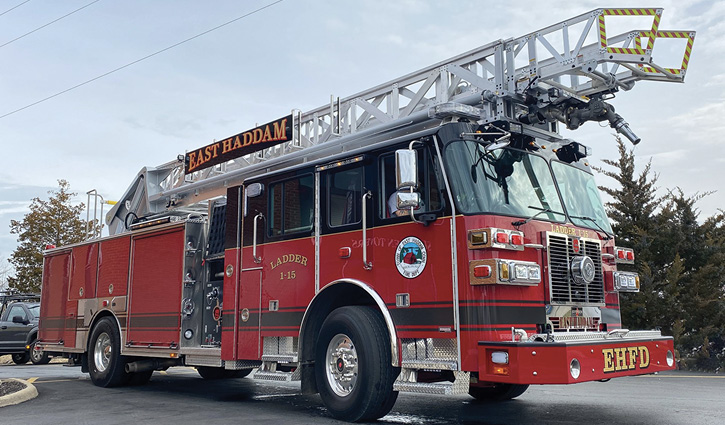
7 Sutphen Corp. built this SL 75 aerial ladder quint for the East Haddam (CT) Fire Department. (Photo 7 courtesy of Sutphen Corp.)
Michael Cox, vice president of sales for Emergency Vehicles Inc. (EVI), says that EVI has been building a number of multi-use rigs that are either a heavy rescue/hazardous materials, a hazmat/command, or a rehab/command vehicle type. “Right now, we’re working on a vehicle for the Seneca (NY) Nation of Indians that is half command and half medical testing,” Cox says. “The front is set up for command with two workstations on each side and a restroom. The middle area has a galley with a medical grade refrigerator, and the rear has a slide-out with an exam table and a wheelchair lift. There’s a center door to access either the front or rear and also a rear access door.”
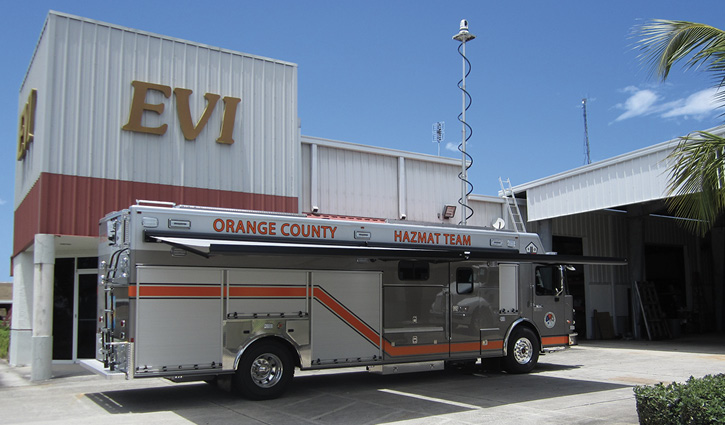
8 Emergency Vehicles Inc. built a dual-use hazardous materials/command truck for the Orange County (NY) Fire Department. (Photo 8 courtesy of Emergency Vehicles Inc.)
Larry Daniels Jr., director of sales for E-ONE, says his company delivered a command/rescue/hazmat truck built on a custom chassis for the Salt River Pima-Maricopa (AZ) Indian Community Fire Department. He notes the fire department wanted to be able to handle hazmat, command, air, decon, and rehab with the new truck, which also serves as a backup system to pump air onto the casino floor of any of their five casinos from the truck’s air support system.
E-ONE also built an eMax rescue-pumper for the Eagle Fire Company, in Oldenburg, IN, with maximum compartment space and a 1,500-gpm pump, a 780-gallon water tank, and a Space Saver air bottle fill station, Daniels says.
Joel Konecky, vice president of sales for SVI Trucks, points out that SVI recently delivered a hazardous materials/wet rescue truck to Las Vegas (NV) Fire & Rescue. Konecky says the truck is on a Spartan Gladiator chassis and cab with a 24-inch raised roof; a walk-in crew area with computer docking stations, storage, and a command desk; a Waterous 300-gpm pump; and a 300-gallon water tank. The rig has an FRC PumpBoss pressure governor, an eight-cylinder SCBA storage module, Hannay electric cable reels, an exterior Samsung 55-inch LCD video display, and two Carefree Mirage lateral arm acrylic patio awnings.
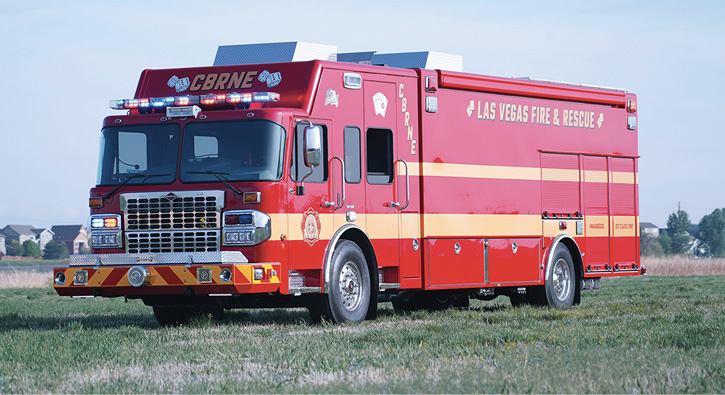
9 SVI Trucks built this hazardous materials/wet rescue truck with a Waterous 300-gpm pump and a 300-gallon water tank for Las Vegas (NV) Fire & Rescue. (Photo 9 courtesy of SVI Trucks.)
Todd Nix, apparatus consultant for Unruh Fire, says Unruh’s forte is building both wet and dry rescues and mini pumper/rescue combinations. “Budgets are still a consideration for many fire departments, so they are choosing to go with either wet rescues or mini-pumper/rescue combinations where they can put two or four firefighters in a rig, pull up to a house, and attack a fire or on a motor vehicle accident scene and go into rescue mode,” Nix says. “The capabilities of pump modules are getting much better, and now we’re putting up to 1,500-gpm pumps on some of these vehicles.”
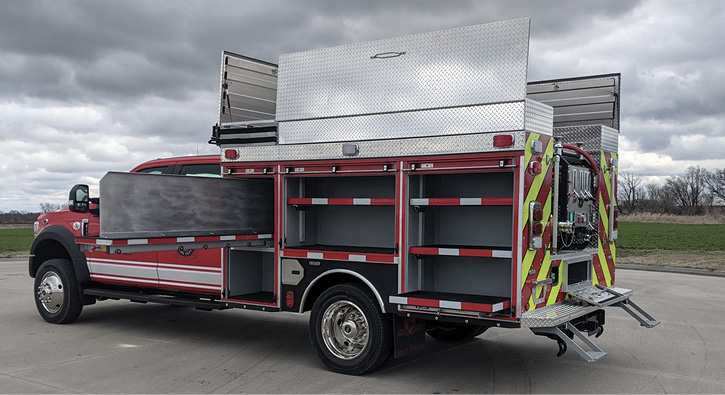
10 The UCLA (CA) Fire Department had Unruh Fire build this wet rescue/EMS response truck to better reach those areas of the campus where larger fire vehicles could not easily maneuver. (Photo 10 courtesy of Unruh Fire.)
Bill Davidson, vice president of sales for Skeeter Brush Trucks, notes that Skeeter has been selling multi-functional vehicles for a number of years. “We’ve been building brush trucks with rescue and EMS capabilities,” Davidson says. “The driver’s side of the truck usually is for fire suppression, while the opposite side holds the rescue equipment. We usually build on a Ford F-550 Super Cab, which is a cab-and-a-half, and remove the rear seats and install the EMS and bunker gear back there. The rest of the body is set up with three compartments on each side, with a 110-inch slide-out under the rear body compartment. This type of truck minimizes the cost of having a vehicle that only does one thing.”
Jason Louque, director of sales for Ferrara Fire Apparatus, notes that Ferrara has been building a variety of multi-use vehicles, including rescue-pumpers, wet rescues, and rescue-pumper-tankers. Louque says Ferrara built a rescue-pumper-tanker on an Inferno medium four-door chassis and cab with an 8-inch raised roof, a 1,500-gpm Waterous pump, and a 3,000-gallon water tank for the Chester (IL) Fire Department.
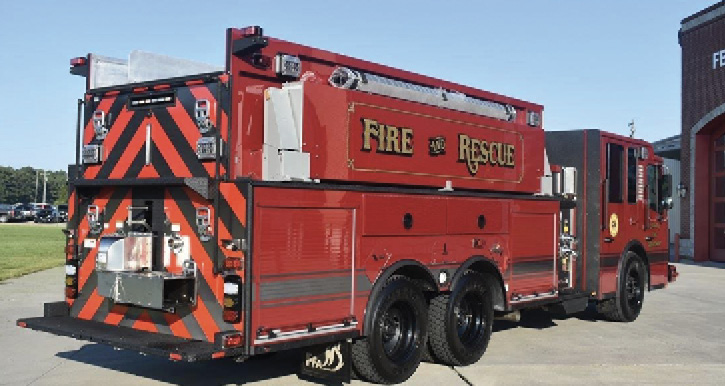
11 Ferrara Fire Apparatus built this pumper-tanker-rescue for the Chester (IL) Fire Department. (Photo 11 courtesy of Ferrara Fire Apparatus.)
Robert Pike, corporate services manager for Fort Garry Fire Trucks, says Fort Garry recently delivered a rescue-pumper-air-light truck to Lanigan (BC) Fire Rescue on an International four-door commercial chassis and cab with an 18-foot walk-around rescue body that has an HMA UHP (ultra-high pressure) pump, a 360-gallon water tank, a powered ladder rack, a Command Light tower, an Irwin 6,000-pounds-per-square-inch breathing air cascade system, a dual bottle fill station, and electric rewind air and power cord reels.
Fort Garry also built a mini-pumper with a rescue body on a Ford F-550 chassis and two-door cab, carrying a Hale 1,250-gpm pump, a 300-gallon water tank, with an Akron Brass Company 1,000-gpm monitor for the Rogers (MN) Fire Department.
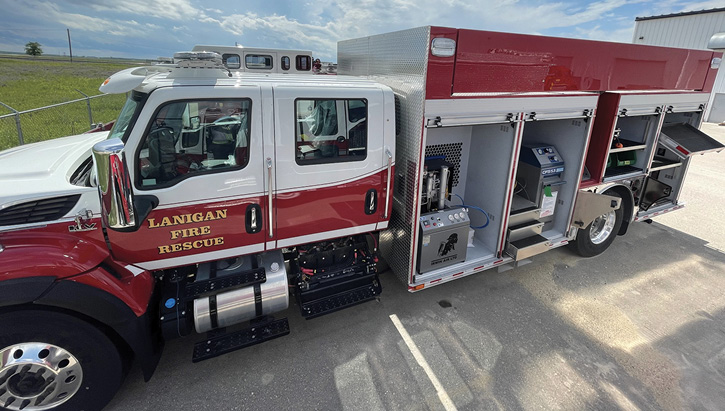
12 Fort Garry Fire Trucks built this rescue-pumper-air-light truck for Lanigan (BC) Fire Rescue. (Photo 12 courtesy of Fort Garry Fire Trucks.)
Jobie Davies, new product development and R&D manager for Seagrave, says Seagrave developed the HydroForce Water Tower with MGS Grupa in Croatia as a multi-purpose apparatus, functioning as a pumper and an aerial water stream device.

13 Seagrave built this HydroForce Water Tower multi-use rig for the Louisville (KY) Fire Department. (Photo 13 courtesy of Seagrave.)
He says the rig is available on a Marauder or Capital chassis and cab and has a small footprint and high-water flow volume from a knuckle boom with a 1,500-gpm waterway with a 60-foot vertical reach and 35-foot horizontal reach with a 360-degree rotation.
ALAN M. PETRILLO is a Tucson, Arizona-based journalist, the author of three novels and five nonfiction books, and a member of the Fire Apparatus & Emergency Equipment Editorial Advisory Board. He served 22 years with the Verdoy (NY) Fire Department, including in the position of chief.

